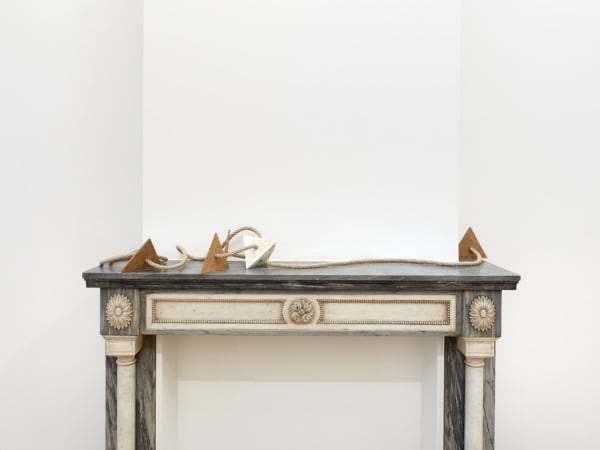Them inside the skin Mariana Castillo Deball
The exhibition has two main characters:
a time-space calendar
a shared skin
To measure – whether distance or time – is to develop a material engagement with the world that is at once practical and conceptual. The exhibition explores sculptural praxis as an expanded skin that comprises space and time.
The tonalpohualli is a cosmological technology for the count of time. Apart from measuring time, it is a divinatory system entangling spatial coordinates, agriculture, and ritual sacrifices. The gods, events and other elements it carried as augural messages defined the way people conducted their affairs and even what kind of people they were likely to become.
The tonalpohualli is a calendar of 260 days, composed of 20-day signs and 13 numbers. Each day is a combination of a day sign and a number, and they run concurrently until all the combinations are exhausted (20x13=260). The day 1 Crocodile is always followed by 2 Wind, 3 House, 4 Lizard, and so on, until the shorter 13 number cycle ends with 13 Reed, after which it continues with 1 Jaguar, 2 Eagle and so forth.
The calendar was depicted in visual manuscripts named tonalamatl, from tonal (day) and amatl (paper). In these books the days were visually displayed in different permutations according to the multiple cycles of the calendar. The books also contained astronomical and medical knowledge, insights into prophecies and protocols for rituals.
The books were crafted of either deer skin or paper, mostly organized as a screen fold. Paper was an important material in the indigenous cosmogony, widely used not just for manuscripts, but also for ritual objects such as body ornaments, clothes, and offerings.
The connection between the body and the environment is present in the calendar, for instance, the signs of the days and the body parts maintained a correspondence. The sap of the amate tree used to make paper was blood, the smoke of fire was human breath, and the tree bark was human skin.
In the calendar, the deity Xipe Totec was often depicted as a man wearing the flayed skin of another on top of his own. The ceremony consisted on the sacrifice of the victim, and the transfiguration of another person through wearing the skin of the sacrificed.
The Nahua concept of ixiptla derives from the particle xip, meaning skin, coverage or shell. A natural outer layer of tissue that covers the body of a person or animal, the skin can be separated from the body to produce garments, containers for holding liquids or parchment as a writing surface. Ixiptla has been understood as image, delegate, character, and representative. Ixiptla could be a container, but also could be the actualization of power infused into an object or person. In Nahua culture, it took the form of a statue, a vision, or a victim who turned into a god destined to be sacrificed. Without having to visually appear the same, multiple ixiptlas of the same god could exist simultaneously.
The skin of the deer and the paper act both as support and ritual signifiers. The book of days departs from a skin and becomes a body. The page 20 of the Borgia codex shows a deer with the 20-day signs assigned to different parts of its body. A skin deer-body-calendar. The codice Tudela has a similar image of an extended deerskin with the day signs inscribed in different parts of its body.
The association between man and deer appear in several narrations, including the story related at the beginning of this text. The deer is the sacrifice offering per excellence, and also a creature that can transmute in something else. Again, it is a game of substitutions and transmutations that depart from the skin and its materiality. In the indigenous cosmogony, the material gives shape, identity, materializes, but also substitutes and personifies, not only by visual analogies but also by subtle material relations.
Skin and paper seem to share the same nature, as the wrapping or envelope of plants, humans and animals. These are the material and symbolic supports of the tonamalatl calendar known until today.
The body of works in this exhibition share the same skin, a skin for thought. It is not a contained skin, but a skin that can be shared, acting as an extended tissue between different bodies.
-
 Mariana Castillo Deball, Tonalpohualli Xipe, 2017
Mariana Castillo Deball, Tonalpohualli Xipe, 2017 -
 Mariana Castillo Deball, Tonalpohualli Green, 2017
Mariana Castillo Deball, Tonalpohualli Green, 2017 -
 Mariana Castillo Deball, Tonalpohualli Petate, 2017
Mariana Castillo Deball, Tonalpohualli Petate, 2017 -
 Mariana Castillo Deball, Tonalpohualli Blue, 2017
Mariana Castillo Deball, Tonalpohualli Blue, 2017 -
 Mariana Castillo Deball, Pedernal II, 2017
Mariana Castillo Deball, Pedernal II, 2017 -
 Mariana Castillo Deball, What’s the matter with you?, 2017
Mariana Castillo Deball, What’s the matter with you?, 2017 -
 Mariana Castillo Deball, Why don’t you say something?, 2017
Mariana Castillo Deball, Why don’t you say something?, 2017 -
 Mariana Castillo Deball, Xipe Tetrahedron II, 2017
Mariana Castillo Deball, Xipe Tetrahedron II, 2017 -
 Mariana Castillo Deball, Tonalpohualli, 2017
Mariana Castillo Deball, Tonalpohualli, 2017 -
 Mariana Castillo Deball, Xipe Tetrahedron I, 2017
Mariana Castillo Deball, Xipe Tetrahedron I, 2017 -
 Mariana Castillo Deball, Tonalpohualli Green, 2017
Mariana Castillo Deball, Tonalpohualli Green, 2017 -
 Mariana Castillo Deball, Xipe couple, 2017
Mariana Castillo Deball, Xipe couple, 2017 -
 Mariana Castillo Deball, A half of an eye, 2017
Mariana Castillo Deball, A half of an eye, 2017 -
 Mariana Castillo Deball, Tonalamatl II, 2017
Mariana Castillo Deball, Tonalamatl II, 2017 -
 Mariana Castillo Deball, Pedernal I, 2017
Mariana Castillo Deball, Pedernal I, 2017 -
 Mariana Castillo Deball, Ixiptla I, 2017
Mariana Castillo Deball, Ixiptla I, 2017 -
 Mariana Castillo Deball, Ixiptla II, 2017
Mariana Castillo Deball, Ixiptla II, 2017 -
 Mariana Castillo Deball, Tonalamatl I, 2017
Mariana Castillo Deball, Tonalamatl I, 2017 -
 Mariana Castillo Deball, An eye and a half, 2017
Mariana Castillo Deball, An eye and a half, 2017 -
 Mariana Castillo Deball, Petate, Xipe, Turquesa, Xipe, Petate, 2017
Mariana Castillo Deball, Petate, Xipe, Turquesa, Xipe, Petate, 2017 -
 Mariana Castillo Deball, Icosahedron, 2017
Mariana Castillo Deball, Icosahedron, 2017 -
 Mariana Castillo Deball, Petate, Xipe, Turquesa, 2017
Mariana Castillo Deball, Petate, Xipe, Turquesa, 2017 -
 Mariana Castillo Deball, Xipe Octahedron, 2017
Mariana Castillo Deball, Xipe Octahedron, 2017 -
 Mariana Castillo Deball, Xipe Tetrahedron III, 2017
Mariana Castillo Deball, Xipe Tetrahedron III, 2017


























